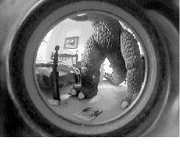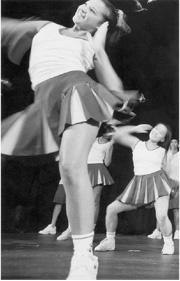THEY DON’T LOOK like much at first glance, but Phil Roach’s untitled landscapes, bland paintings of wood and water that commonly turn up at garage sales, are wickedly clever. Each painting contains a peephole; behind it is a hidden but familiar world. Roach, a recent UW MFA grad, has outfitted the backs of the paintings with dioramas depicting various rooms in a house. They are so detailed and convincingly realistic that they look like photographs or videos. One diorama depicts an attic with exposed insulation; on the far left stands a tiny print of the same painting that you’re looking through. Another setup shows a den, a reclining chair in front of a TV, newspapers scattered across a table, a floor lamp, and a door. The TV, it turns out, is actually a mini handheld tuned into the same station all day long. During my visit to the gallery, I saw commercials for Pepto Bismol and Payless Shoes, and a segment of Inside Edition.
Home
SOIL Gallery, ends August 27
Roach’s works are part of the current show at SOIL, curated by Leslie Clague and Demi Raven, who have gathered conceptual photographers, sculptors, and installation artists from around the country to work with the theme of “home.” It’s a strong, tight exhibit, offering a heady trip through the physical spaces of a home as well as the psychological and cultural baggage within.
BRENT WATANABE’S Thrift Store Tape is worth sitting through at least once. Watanabe has sifted through a found videotape that records the nonevents of a suburban family: Mom feeding baby, a toddler staring into the camera. Despite its low production quality and the aimlessness of a home movie, the video manages to be strangely appealing, thanks to Watanabe’s editing and manipulation. Images are often pushed into half of the screen, and closeups of faces come across in dreamy slow motion. The unlikely star of the show turns out to be the oldest daughter, Kristen, who wears big glasses and hides her face. Her father, working the camera, scolds her—”Kristen, why do you always do that?”—and threatens to return the Camcorder to the store. Three years later, Kristen, taller, and with longer hair, still doesn’t want to be filmed. “Daaad,” she complains as the camera closes in on her. The eight-minute loop includes a scene from Kristen’s slumber party, with girls jumping and screaming in their nightgowns. Hamming it up, Dad picks up a guitar and sings a country song for the girls. By this time, it’s hard not to wonder what’s become of these people, and why the tape that was once so precious came to be discarded, its deeply personal contents becoming ours.
I don’t really know what to make of Enrico Groplus’ table full of crap at the back of the room, except that its disarray gives the exhibit a real lived-in quality, if a bit of repulsiveness. A square coffee table is covered with Styrofoam take-out trays, empty bottles of bourbon and wine, a dried-up plant, and an ashtray full of cigarette butts and toenail clippings, among other junk. Indeed, home is where the clutter is.







